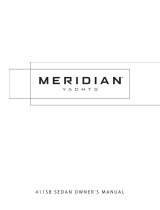
Owner’s Manual
Fire Emergency - 78 Viking Sport Cruiser 61FY
v1.0
••••••••••••••••••••••••••••••••••••••••••••••••••••••
Despite precautions, fire is always a
possibility
This is true at home or on the water. At sea you must
have a plan for the safety of all aboard. Discuss a fire
fighting plan with your local Coast Guard, they are experts
in this field.
Instruct crew and guests how to use the dry chemical
extinguishers and how to aim at the base of the fire. It is a
good idea to place additional portable extinguishers where
there is space. With fire, speed of response is critical, the
first few minutes count.
All aboard should know extinguishers are installed in all
living areas, typically in cupboards. A small red sticker at
the lower right corner of a cabinet or locker
door indicates where they are located. Instruct
passengers to go on deck in the event of a
fire. Note emergency escape exit E.
Classes of fire: A, B, C
Class A fires:– wood, cloth, paper, rubber and plastics.
Lacking an extinguisher, a bucket of water works for small
Class A fires.
Class B fires:– flammable liquids: paint, diesel fuel, oil, grease
etc. such as might occur in the engine room. Never use
water in there. The small portable chemical extinguishers
are suitable for class A, B, & C small fires.
Class C fires:– electrical equipment. The non conducting
feature of a dry chemical extinguisher is of prime impor-
tance. Also, immediately shut off power to the electrical
equipment that is the source of the fire.
Portable extinguishers
The portable extinguishers on board are of type ABC. If
they are used, clean up the chemical residue as soon as
possible, or corrosion may occur. REPLACE used extin-
guishers as soon as possible with the same size unit or
larger. Check pressure gauges monthly to ensure they
are on green and will work when needed. Yearly, remove
each unit from its bracket and give it a good shake to
loosen internal materials. Always ensure free access to
extinguishers.
Hazardous materials
Do not store used rags or paper towels that have been used for
clean up. Make proper provision for clean up items and their
disposal. Don’t let the engine room or lazarette be used for
storage – free access to the equipment there is essential in
case of fire or other emergency.
Flammables such as acetone, paint, thinners, etc. should
be stored in secure containers and in a safe location away
from living areas or electrical equipment.
Living space fire safety
Fires in living areas are often
caused by careless smoking, or
by candles. Such fires are a typi-
cal application for the portable
fire extinguishers aboard your
vessel (in clothes closets, etc.).
Guests must know where the
portable extinguishers are and how to use them.
Demonstrate how to release the bottle holding clamp
and how to pull the safety pin out of the trigger. Check
the gauges monthly to ensure they are fully charged.
Check them also before a long voyage.
These extinguishers may be used on all three classes of
fire. It’s a good idea to keep a 5-10 pound HALOTRON 1
ABC portable extinguisher handy for electrical fires. There
is no clean up and they have greater discharge range.
Using a fire extinguisher
Pull the pin. Stand back about 6 feet. Aim at the base of
the fire and sweep back and forth. A cloud of powder will
obscure the fire shortly after discharge starts. Be pre-
pared for this because you will no longer be able to see
the base of the fire.
Discharge is ONLY 13 SECONDS, so keep spare units on
the vessel. More than one unit may be needed to put
out even a small fire.
After a fire the residue must be cleaned up as soon as
possible. The sodium bicarbonate powder is difficult and
tedious to clean up.













